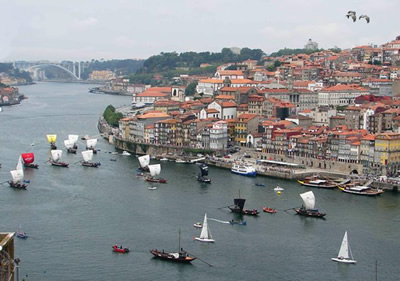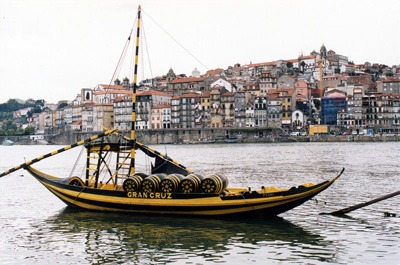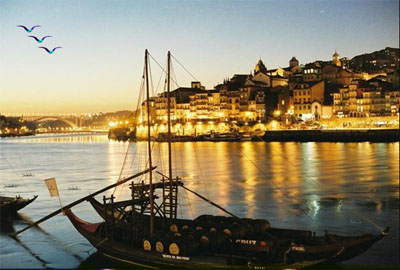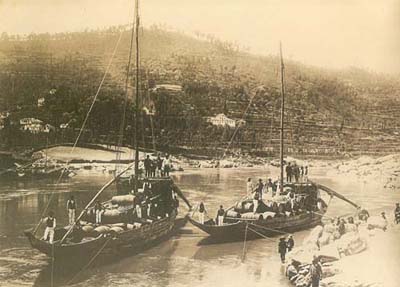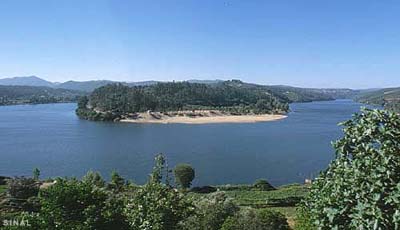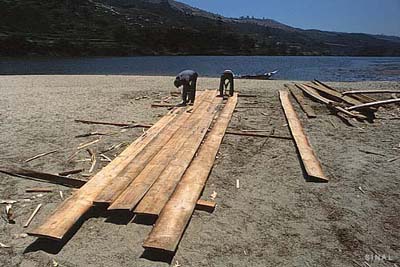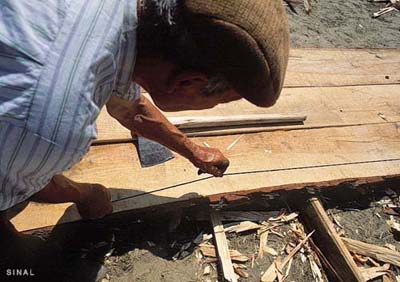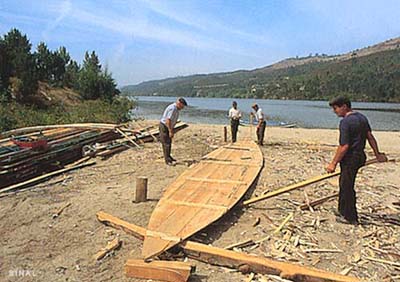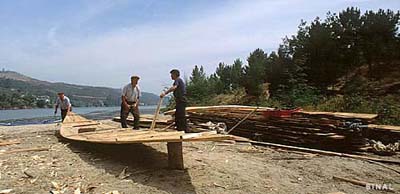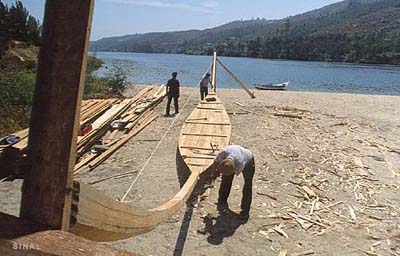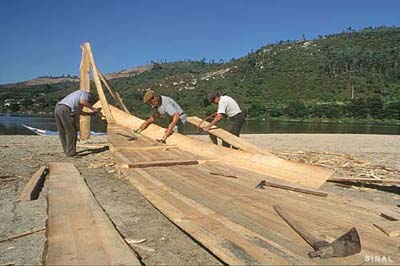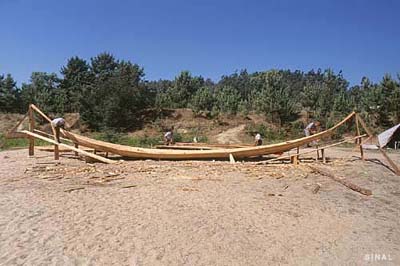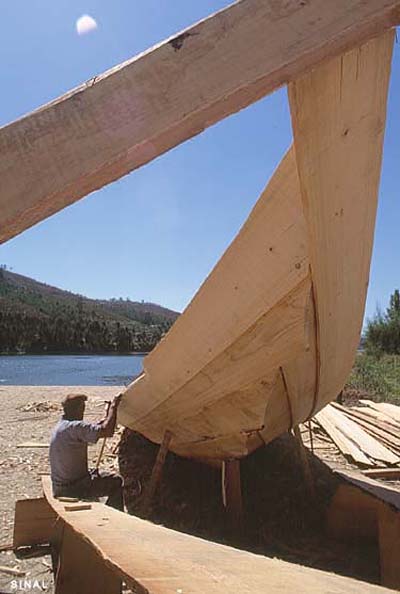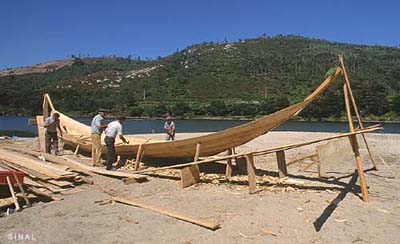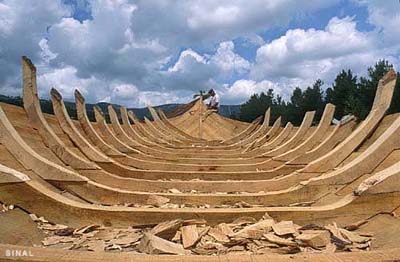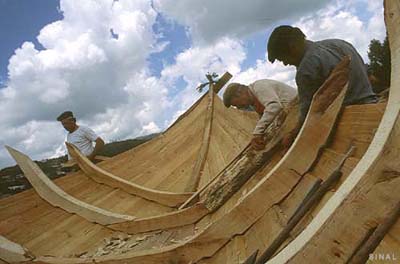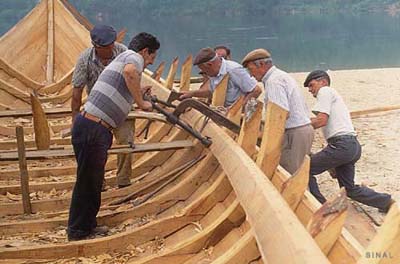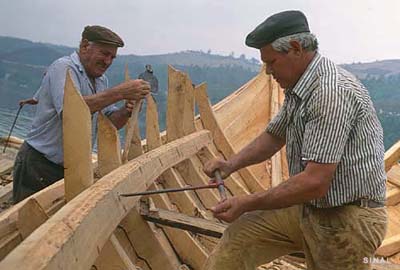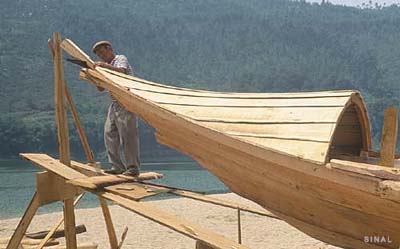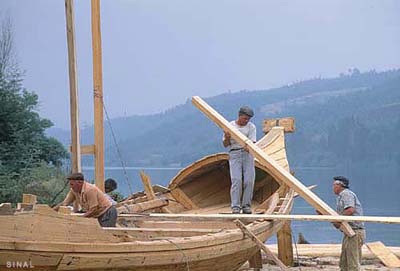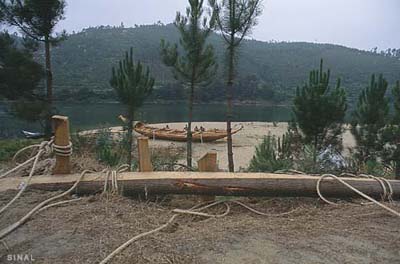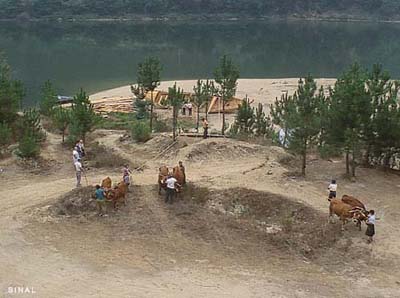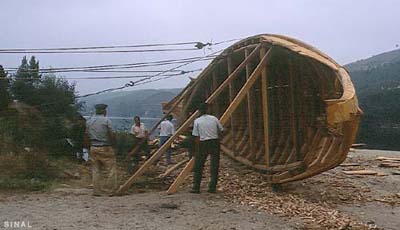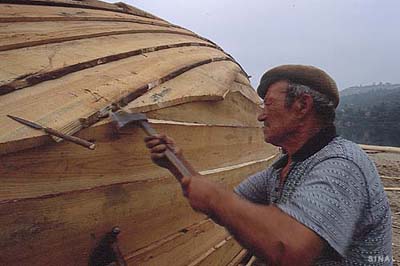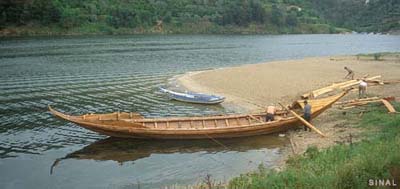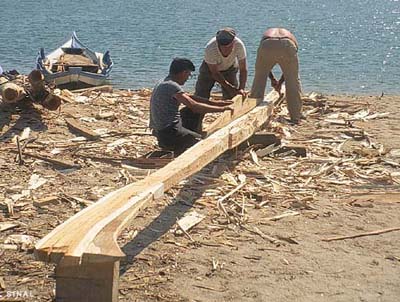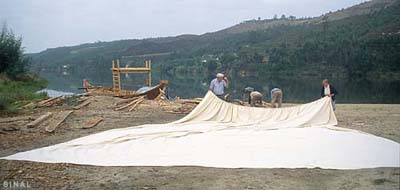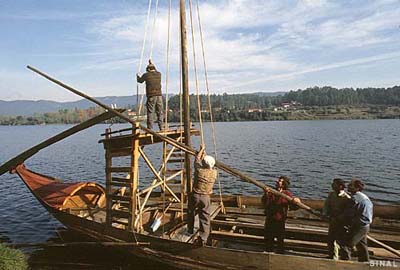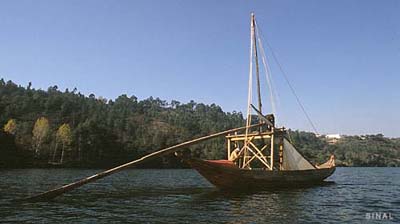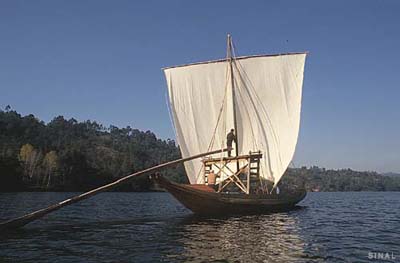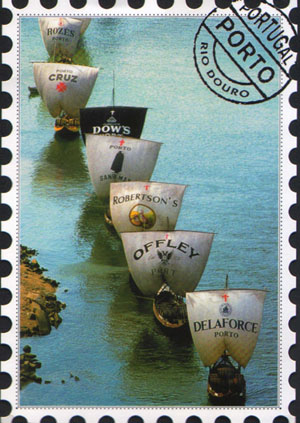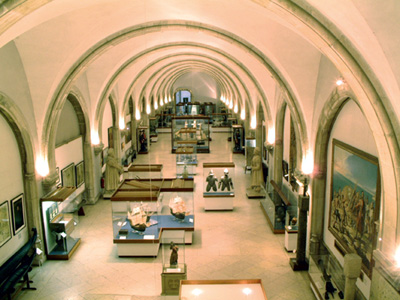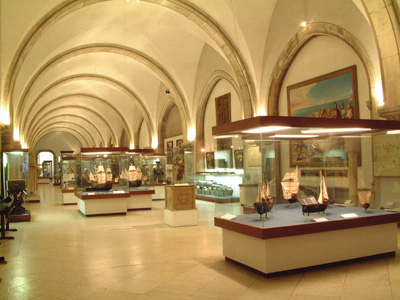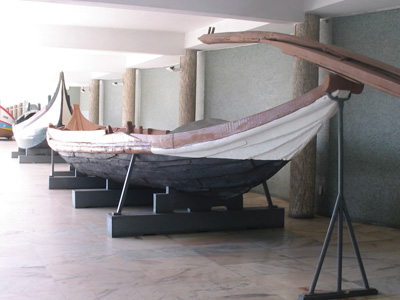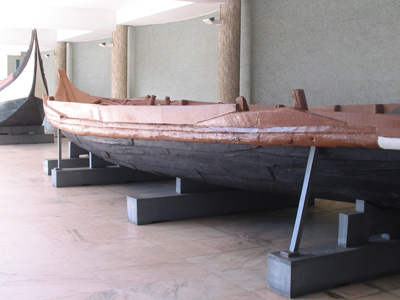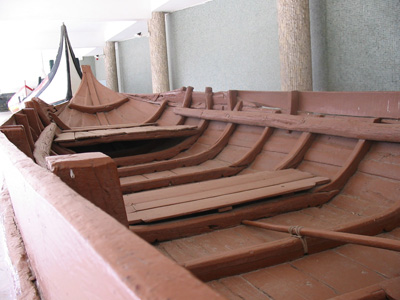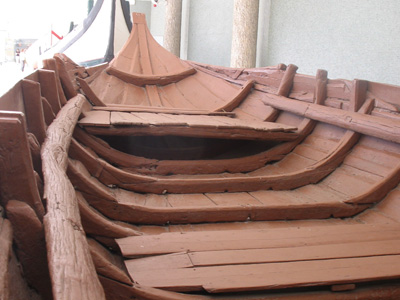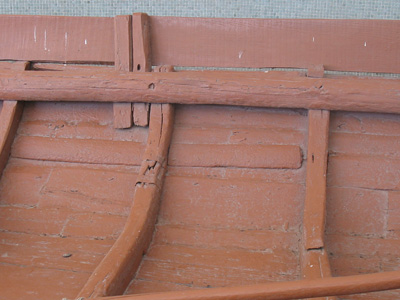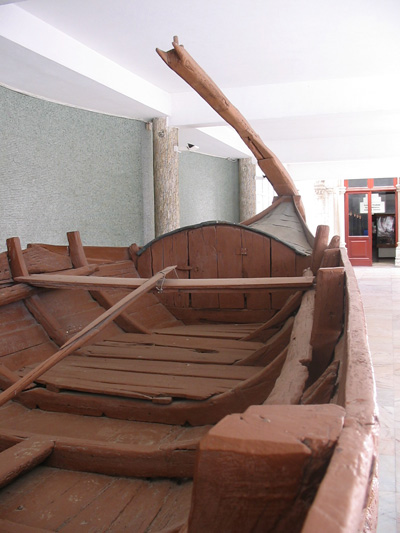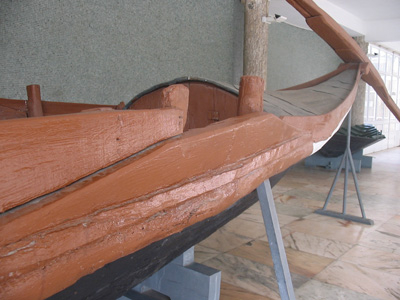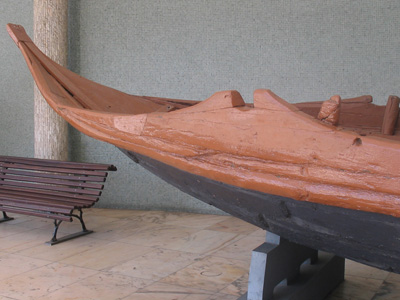Well, we have here on a net in Portugal, a Portuguese Forum - "The City Amazingly" "A blog of images and a few words about Porto, one extraordinary blog." Wherein appeared an article by Mr.Carlos Romão, concerning the construction of the last Rabelo, an antique river ship used to carry Porto, Portugal wine barrels. (These links pop into a new window, so you may come back and read the rest of the story.)
For thousands of years, foreign connoisseurs have cherished the wine that is grown in northeast Portugal on the mountainsides along the Douro River.
Douro wine was often mentioned in royal decrees, and by the 13th century it was shipped down the Douro River to the coastal town of Porto, and exported as far afield as Holland.
By the beginning of the 17th century as many as 1,200,000 cases reached Porto each year, and in 1638 a German diplomat named Cristiano Kopke founded a Douro wine shipping company that is still in existence today. In 1675 wine destined for Holland was called for the first time by its modern name: Porto. Although, by law, only wine produced in Portugal may be called Porto, other countries accept and respect its translation (Port or Port Wine).
These reaches of the Douro have a micro-climate allowing for cultivation of olives, almonds, and especially grapes important for making the famous Port wine. The region around Pinhão and São João da Pesqueira is considered to be the center of Port wine, with its picturesque quintas or farms clinging on to almost vertical slopes dropping down to the river.
Traditionally, the wine was taken down river in flat-bottom boats called rabelos, to be stored in barrels in cellars in Vila Nova de Gaia, just across the river from Porto. As you cross the bridge LuÃs I to Vila Nova de Gaia, you may admire the Rabelo boats on the riverbank. They are the symbol of the famous Port Wine and the trademark of the Port Wine Cellars.
The Rabelo boat, which was invented in the 9th century, was used for transporting the products from the farms of the Douro for centuries. In 1792, the Companhia Geral da Agricultura e Vinha do Alto Douro published numerous charters and documents concerning this type of boat, therefore establishing the identity of the Rabelo.
The purpose of its peculiar shape was to overcome the natural obstacles of the Douro river and to make the boatmans task easier.
The large amount of Port Wine produced in the farms required frequent transportation downriver. The journey lasted more than a week and the conditions were precarious, often leading to dangerous accidents.
Following the construction of the railway and the improvement of the public highway, the Rabelo boat gradually lost its importance. Finally, the dams along the Douro river brought its activity to a standstill.
Nowadays, this symbol of the Port Wine and trademark of the Cellars still competes fiercely for a place of honour in the regatta of S. João, organized by the Confraria do Vinho do Porto (Port Wine Brotherhood) on June 24th (municipal holiday).
http://nl.youtube.com/watch?v=IX6TVimap-s&feature=related
Make a brief but virtual visit to Porto via YouTube.
Portugal's Douro River
"Europe's most beautiful river"
For thousands of years, foreign connoisseurs have cherished the wine that is grown in northeast Portugal on the mountainsides along the Douro River.
Douro wine was often mentioned in royal decrees, and by the 13th century it was shipped down the Douro River to the coastal town of Porto, and exported as far afield as Holland.
By the beginning of the 17th century as many as 1,200,000 cases reached Porto each year, and in 1638 a German diplomat named Cristiano Kopke founded a Douro wine shipping company that is still in existence today. In 1675 wine destined for Holland was called for the first time by its modern name: Porto. Although, by law, only wine produced in Portugal may be called Porto, other countries accept and respect its translation (Port or Port Wine).
These reaches of the Douro have a micro-climate allowing for cultivation of olives, almonds, and especially grapes important for making the famous Port wine. The region around Pinhão and São João da Pesqueira is considered to be the center of Port wine, with its picturesque quintas or farms clinging on to almost vertical slopes dropping down to the river.
Traditionally, the wine was taken down river in flat-bottom boats called rabelos, to be stored in barrels in cellars in Vila Nova de Gaia, just across the river from Porto. As you cross the bridge LuÃs I to Vila Nova de Gaia, you may admire the Rabelo boats on the riverbank. They are the symbol of the famous Port Wine and the trademark of the Port Wine Cellars.
The Rabelo boat, which was invented in the 9th century, was used for transporting the products from the farms of the Douro for centuries. In 1792, the Companhia Geral da Agricultura e Vinha do Alto Douro published numerous charters and documents concerning this type of boat, therefore establishing the identity of the Rabelo.
The purpose of its peculiar shape was to overcome the natural obstacles of the Douro river and to make the boatmans task easier.
The large amount of Port Wine produced in the farms required frequent transportation downriver. The journey lasted more than a week and the conditions were precarious, often leading to dangerous accidents.
Following the construction of the railway and the improvement of the public highway, the Rabelo boat gradually lost its importance. Finally, the dams along the Douro river brought its activity to a standstill.
Nowadays, this symbol of the Port Wine and trademark of the Cellars still competes fiercely for a place of honour in the regatta of S. João, organized by the Confraria do Vinho do Porto (Port Wine Brotherhood) on June 24th (municipal holiday).
http://nl.youtube.com/watch?v=IX6TVimap-s&feature=related
The smallboats seen here in Porto, with the broad sails are what this article discusses.
This is an unique document and is the only one of its kind. In my opinion, it is an excellent recent historic document and deserves republishing to help preserve its historic significance. The two languages are presented side by side, the original document in Portuguese to preserve the original inflection of the story and then to the right is an English translation. Please be aware that the following is a work in progress. For now it is a direct translation, from the original Portuguese using Googletm translator. The translation to English is a bit rough in places. Please excuse this, as the English text will be further edited. But by all means, please enjoy your visit, as we follow along this story.
The construction of the last Rabelo, an antique river ship used to carry Porto wine barrels.
A group of naval carpenters (today, have all passed away…) began this “adventure†to build the last Rabelo! They chose one little river island named “LOMBA†in Douro and after a nice lunch ---sardines grilled with red wine, very much enjoyed in Portugal, they choose the appropriate trees to make the boat! The barque is constructed step by step, as you see. .
This film entitled "The Architecture of the Rabelo", a documentary produced in 1992 in collaboration with the acknowleged naval archaeology researcher Octávio Lixa Filgueiras, is now available on DVD-video format with menu options for soundtrack in Portuguese, English and French, portraying a detailed survey of the way the Rabelo boats were built on the banks of the River Douro, in the North of Portugal. These characteristics, widely known of the boats used to carry the Port Wine barrels stopped sailing over 40 years ago. The construction of a boat Rabelo, may pass unnoticed to most people, but what they do not know, is what makes it odd.
This documentary will clarify the details of greatest interest of a kind of boat building which is practically peculiar to the River Douro and which represents exactly the Nordic processes of wooden ship construction, that is the hull is shaped in clinker planking before the ribs are fitted. Molds are not used, the shapes being derived from basic measurements, the experience of a master craftsman inherited from the practical experience of many generations and provides one of the rare, perhaps last, opportunities to record the sights of a lost tradition: on a sand beach of the Douro; directed by the last master boat builder of the river with the few remaining artisans who had worked with the masters of their trade.
This film entitled "The Architecture of the Rabelo", a documentary produced in 1992 in collaboration with the acknowleged naval archaeology researcher Octávio Lixa Filgueiras, is now available on DVD-video format with menu options for soundtrack in Portuguese, English and French, portraying a detailed survey of the way the Rabelo boats were built on the banks of the River Douro, in the North of Portugal. These characteristics, widely known of the boats used to carry the Port Wine barrels stopped sailing over 40 years ago. The construction of a boat Rabelo, may pass unnoticed to most people, but what they do not know, is what makes it odd.
This documentary will clarify the details of greatest interest of a kind of boat building which is practically peculiar to the River Douro and which represents exactly the Nordic processes of wooden ship construction, that is the hull is shaped in clinker planking before the ribs are fitted. Molds are not used, the shapes being derived from basic measurements, the experience of a master craftsman inherited from the practical experience of many generations and provides one of the rare, perhaps last, opportunities to record the sights of a lost tradition: on a sand beach of the Douro; directed by the last master boat builder of the river with the few remaining artisans who had worked with the masters of their trade.
Architecture of Rabelo
Author: Mr. Carlos Romão
|
I PARTE
Mestre Arnaldo Pereira, então com 80 anos, natural de Avintes, construtor de barcos valboeiros utilizados na pesca e transporte no troço final do rio Douro; Júlio Pereira, natural de Avintes, era o mais novo, com 59 anos, filho do grande construtor Alfredo Francisco, irmão do mestre Arnaldo e de profissão carpinteiro de valboeiros e barcos de pá; Manuel Monteiro, nascido em Bitetos, então com 71 anos, filho de João Rouquinho, célebre arrais do Vinho do Porto, e ele próprio marinheiro de barcos rabelos e barquinhas; Miguel da Silva, de Santiago, Melres, tinha 62 anos; antigo marinheiro e pescador do rio, além de carpinteirar foi o cozinheiro deste grupo; Arnaldo Vieira, da praia da Areja, com 60 anos, arrais de rabões, barqueiro e pescador do rio funcionou como ajudante do mestre. |
PART I
Master Arnaldo Pereira, then 80 years old, was born at Avintes, a maker of boats valboeiros used for fishing and transportation in the final stretch of the river Douro; Julio Pereira, was also born at Avintes, he was the youngest, at 59 years, the son of the great builder Alfredo Francisco, brother of Master Arnold. A carpenter by profession of valboeiros(typical fishing boats) and of paddle or row boats; Manuel Monteiro, was born at Bitetos, then 71 years old, the son of John Rouquinho, famous skipper of the Port wine boats Rabelos and barquinhas; Miguel da Silva, of Santiago, Melres, was 62 years old. A former sailor and fisherman of the river, and also a carpenter, was the cook of the group; Arnaldo Vieira, was born at Praia da Areia, was 60 years old, a skipper of rabões, boatman and fisherman of the river, was 2nd in charge, as assistant to the master. |
| A Arquitectura do Rabelo é o tÃtulo de um estudo do prof. arquitecto Octávio Lixa Filgueiras , que serviu como roteiro para um filme documentário produzido por José Monteiro e realizado por VÃtor Bilhete. Este documentário correspondeu talvez à última oportunidade de fixar imagens para o futuro, de uma tradição hoje perdida: a construção de um barco rabelo por um dos últimos mestres calafates do rio, já desaparecido, com alguns artÃfices que com os mestres trabalharam. O processo decorreu em absoluto respeito pelo método nórdico de carpintaria naval, ou seja a formação do casco antes da montagem das cavernas. Sem máquinas, apenas com o esforço humano, e sem moldes, as formas foram obtidas a partir de medidas básicas tradicionais, o gosto do artista e a prática de muitas gerações. As filmagens decorreram entre Junho e Agosto de 1991 em vÃdeo e em pelÃcula de 35mm. Infelizmente não houve suporte financeiro para a montagem da versão cinematográfica, que se mantém em negativo. A versão DVD pode ser adquirida na SinalvÃdeo , a quem pertencem os direitos das fotografias aqui exibidas, por correio electrónico para: Comecemos então pela apresentação dos «artistas-artesãos-figurantes» como lhes chamou Lixa Filgueiras , autor do guião aqui adaptado livremente. |
The Architecture of Rabelo is the title of a study of Professor of Architecture: Octávio Lixa Filgueiras , who served as script writer for a film documentary produced by Joseph Monteiro and held by Vitor Bilhete. This documentary was perhaps the last chance to fix images for the future of a tradition now lost: the construction of a boat Rabelo by one of the last master caulker of the river, with some artisans who worked with him in this task. The process took place in strict compliance with the method of Nordic European naval carpentry, or the formation of the hull before the assembly of the timbers. Without machines, only with the human effort, and without molds, the forms were obtained from traditional basic measures, the taste of the artist and the practice of many generations. The filming took place between June and August 1991 on video and film from 35mm. Unfortunately there was no financial support for the assembly of the film version, which remains in a negative form only. The DVD version can be purchased in SinalvÃdeo, who owns the rights of the photographs shown here, by e-mail to: Let then the presentation of the "artist-craftsmen - figurantes' as they were called by Lixa Filgueiras, author of the script adapted here freely. |
| O local escolhido para a construção do barco foi o areio da Lomba, a poucos quilómetros do Porto, devido à importância do trabalho se realizar num espaço aberto e amplo, permitindo o acerto a olho do apuramento das formas do casco e a fruição da própria vida do rio. Geralmente não havia estaleiros fixos. Os barcos construÃam-se nas praias junto à s povoações dos clientes que se entendiam com os mestres acordando as condições: o tipo e o tamanho do barco medido em pipas; à jorna ou por ajuste de preço; com ou sem fornecimento de materiais ou de comida. Navegar no mar é uma coisa, mas navegar à vela contra a corrente de um rio, só um barco de caracterÃsticas muito especiais o pode fazer. |
The place chosen for the construction of the boat was the sandbank named Lomba, a few kilometres from the town of Porto, the importance of this work needs an open and wide space, allowing the adjustment by eye( only tool used at the begining) of the clearance of the hull forms taken by the workers at the same time they are also enjoying the life of the river side. Usually there were no fixed dockyards. In the past the boats were built on the beaches near the villages where customers who understood the technical language of the carpenters, either agreeing…or not with the conditions: the type and size of the boat, measured in capacity of barrels, an adjustment of price; paid by day or total with or without supply of materials or food. Navigating the sea is one thing, but navigating the sailing against the current of a river, only a vessel of very special characteristics can do. |
| Se o mestre era de fora e trazia alguns ajudantes, montavam uma barraca onde se instalavam. A comida era cozinhada no próprio local da obra. | If the master was outside and brought some helpers, they would set up a tent where they would stay. Cooking facilities were also set up inside for preparing the food, and for escaping the weather on stormy days. |
| Contratada a obra por ajuste de preço, o mestre Arnaldo escolheu as árvores que lhe convinham para a madeira necessária. | Agreeing with the price, the master Arnaldo chose the trees to be appropriated for wood if necessary. |
| Inicia-se a construção do rabelo pelo fundo chato - o sagro, estrado lenticular alongado constituÃdo por número impar de pranchões de 4 cm de espessura. As tábuas pregam umas à s outras, de encosto, de modo a que o fundo seja autêntico fundo de prato, ao contrário do dos barcos do troço final do rio, cujos fundos são de tábua trincada. Passada uma corda a meio do estrado donde sairá o sagro, marcam-se os terços - na verdade uma divisão em quatro partes iguais - e nessas marcas estabelecem-se as larguras simetricamente, com a ajuda de um compasso ou dum sarrafo. | The basic construction of the Rabelo, named “ Sagroâ€, is begun. An elongated, lenticular platform, consisting of odd number of planks - 4 cm thick. The boards join to each other perfectly side by side, forming an authentic bottom of a dish, unlike the boats in other parts of the river, whose hulls are of mismatched boards. Using a marking cord in the middle of the platform the “Sagroâ€, is then marked to a division of four equal parts, being set symmetrically, with the help of a compass or a lath. |
| Estas marcações e o contorno do sagro são feitas com a linha batida. A linha é embebida em água e impregnada com pó de cortiça queimada, permitindo a marcação directa. É de salientar a perÃcia com que o mestre consegue realizar alinhamentos curvos por este processo. | These markings and the contour of “Sagro†are made with a snap line. The line is soaked in water and powder of burnt cork, allowing a direct mark. The master is able to perform precise alignments of curved joinery by this process. |
| Depois de serrado o contorno do sagro e feito um primeiro solinhado - corte oblÃquo no rebordo exterior - pregam-se as travessas que o mantêm solidário. | After sawing and shaping of the contour of “Sagroâ€, making a first “solinhadoâ€-oblique cutting edge in the outer-edges, the cross beams are nailed giving strength to the basic hull plate.. |
| Começam então a cravar as estacas do picadeiro. 0 picadeiro é formado por uma série de estacas cravadas no chão e acertadas em altura de modo a que o sagro apresente o perfil desejado. | Now, stakes are driven in precise spots. The actual building area is formed by a series of stakes driven into the ground marking out the desired profile. |
| 0 sagro acaba por ser transportado para cima do picadeiro. Em caso de necessidade usavam-se pedras ou sacos de areia para o sujeitar ao perfil definido pelas estacas. | The “Sagro†is now transported up to the building area. In case they are needed, stones or bags of sand are used to force the profile predefined by the stakes. |
| Segue-se o traçado - batendo a linha -,feitura e montagem das oucas, as peças de reforço interior, da proa e da popa. A sua colocação nas extremidades do sagro obriga a várias verificações: as alturas são tomadas nos extremos do sagro, para as linhas estendidas dos terços aos extremos dos bicos; o acerto a olho e de longe do perfil do conjunto do sagro mais oucas, ou seja o próprio perfil do barco; o alinhamento e acerto no plano vertical, a partir da linha estendida de proa à popa, de onde se tiram os prumos. Assim, as oucas ficam mantidas na devida posição, com as estacas sustidas por pernas. | Here the builder follows the route - marked by the snap line - making and assembling of the “oucas†(parts of strengthening interior), the bow and stern. Its placement on the extremities of â€Sagro†will require the various checks: the extreme heights are taken of the “Sagroâ€, and to the lines extended by thirds of the extremes of the nibs of the prow and stern, the adjustments are made by eye and always far from the profile as a whole, ie. the actual profile of the boat. Alignment and adjustment in the vertical plane is from the line extended from bow to stern, from where the workers take out the plums. Thus, the “oucas†are retained in position, with the piles supported for legs. |
| 0 sagro, consolidado com travessas de reforço provisórias, vai começar a ser urdido. Urdir o barco é vesti-lo com o tabuado dos costados. Urdir the boat is clothe it with the tabuado of costados. As primeiras tábuas são as biqueiras, uma a cada bordo - peças triangulares a formar o rodo, à proa, abraçam a ouca pelo exterior e terminam no terço de vante. Repare-se no ajuste das tábuas que têm que ficar empenadas, tomando a forma com a ajuda de paus que funcionam como alavancas. | The “Sagroâ€, consolidated with provisory beams to boost relief, are installed (“urdirâ€) with garboard stakes. The first boards are gutters one by each board to form triangular pieces-the path to the bow, they adjoin directly to the outside of the “ouca†and end one third of the prow. Look at the boards for adjustment that must be stiffed, which takes form with the help of sticks that act as levers. |
| A própria configuração da parte superior das biqueiras é acertada no sÃtio, batendo-se a linha. As biqueiras sobrepõem-se ao solinho - corte oblÃquo no rebordo exterior - do sagro e são por sua vez solinhadas para receberem a primeira fiada corrida, também chamada primeiro solinho. 0 primeiro solinho é constituÃdo por três peças a cada borda. Monta-se a primeira à proa, segue-se a de ré e finaliza-se com a do meio, que remata o conjunto. | The actual configuration of the upper gutters is right on the site, again following the marked line. The gutters overlap to the solinho-oblique cutting edge to the outside-the “Sagro†is chiselled to receive the first row race, also called the first chiseling. Mounted first to the bow, and then to the stern and joining with the middle, finishing this part of the construction. |
| As fiadas corridas - o primeiro solinho, o segundo solinho e as corridas - não são inteiriças. As peças que as constituem ficam ligadas por uniões de escarva lavada contrafiadas para dar mais segurança aos costados. É sempre o mesmo sistema: tábua a um bordo, tábua a outro, borda trincada, emendas com uniões de escarva, acerto à linha do bordo superior de cada fiada, solinhados, etc. | The rows races - the first solinho, the second one, and the others are not totally finished. The pieces that remain are linked by unions (this type of union is named in Portuguese language “escarva lavadaâ€) to give more security to broadsides. It is always the same system: board to a board, the cracked edge board , with amendments unions or joints, join the line of the upper edge of each row, solinhados, etc.. |




